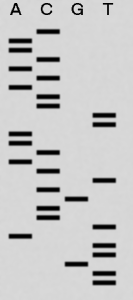1. What is the mass of this peptide: LNVEASAPQTR? (4 points)
(+2) 113.1+114+99.1+129+71+87+71+97.1+128.1+101.1+156.1=1166.6(+4)+(2*mass of hydrogen)+(mass of oxygen)(+2) = 1184.6
I accepted 1184 or 1185, but not higher or lower. Also,
if you took the mass of argenine to be 175 - what it would appear as on a spectrum - then that mass also includes a proton. Thus, some people
either forgot to add the 18 to their total mass or had too much mass from adding in protons.
2. Sequence homology or similarity information is used in both the similarity based and the comparitive
genomics approaches for gene prediction. What is the difference between these two approaches? (4 points)
(Note: I was very liberal with the grading of this due to the opaque nature of the question)
Comparitive: By comparing two genomes you can obseved the percent conservation across a given gene. Those spots where there is a spike in the total conservation are evidence of ORFs or exons. (+2)
Similarity: Take gene from organism X blast against organism Y, take highest score regions. Use suplemental information such as known splice signals to complete annotation. Similarly using cDNAs and ESTs to derive annotations was an exceptible answer. (+2)
The main point I was looking for was the idea that one was based on scanning a genome for spikes in conservation, whereas the other is a directed approach.
3. What is the(+2)m/z of the peptide in question #1? (2 points)
(Note: if you had miscalculated the mass in question I did not punish you on this question as long as you got the right answer based on that number)
Formula: (Mass+X*Protons)/X
(1184.6+2)/2=593.3 (+2)
4. Hypothetical organism X has the following DNA sequence. Part of the promoter is indicated by the
bollded sequence. Transcription starts at the non-bold A/T base pair.
5 xxxx TATTTGATAG CTCTATGCAT GCATGGGTCC TGAAGTTCAG ATCTTTGAGT CATAGGAGTC 3
3 xxxx ATAAACTATC GAGATACGTA CGTACCCAGG ACTTCAAGTC TAGAAACTCA GTATCCTCAG 5
a) Give the RNA sequence of the first 25 bases following transcription.
b) What are the first 5 codons of the resulting protein?
(6 points)
Wrote the template strand. AUGCAUGCAUGGGUCCUGAAGUUCAGA (+2)
Wrote U instead of T. (+2)
Got the right Amino acids. Met-His-Ala-Trp-Val (+2)
5. Find the a2-b2 ion pair and the first two N-terminal amino acids (in order) of the following spectrum: (+6 points)
Found the right two peaks; 203.05, 175.12. (+2)
(Note: gave half credit if you chose peaks 302.19 and 274.07)
Determined that the two amino acids were S and D. (+2)
Determined that the correct order of the amino acids was S then D. (+2)
6. What is a contig? (+4 points)
A contig is a contiguous stretch of sequence (+2) derived from DNA of overlapping (+2) segments.
(note: there exists a variety of definitions for contig, ultimately in a genomics context the definition of a congtig must include the idea of sequence)
7. What are the two low mass ions that are diagnostic of the y1 ions for a
tryptic peptide? (+2 points)
Arginine (R) - 175 (+1)
Lysine (k) - 147 (+1)
8. You sequence an EST from your laboratory's favorite inbred mouse strain, and
BLAST it against
the mouse genome to match the renin gene. However, you did not get an exact matc
h:
CATCCGCAAGTTCTATACA-GAGTTTGATCGGCATAACAATCGCGTTGGATTC-GCCTTG
||||||||||||||||||| |||||||||||||||||||||||| |||||||| || | |
CATCCGCAAGTTCTATACACGAGTTTGATCGGCATAACAATCGCATTGGATTCCGCATGG
Is there a mistake in the database? Explain your answer.(+4 points)
No, the mouse genome was the conglomeration of many different mice. These mice represent a particular substrain that may be different than your particular substrain of choice (+2). Individuals accumulate mutations over time meaning any one idividual will differ from the reference genome (+2).
9. What are the two dimensions in 2D-gel electrophoresis? (+2 points)
Charge/Isoelectric point. (+1)
Molecular Mass. (+1)
10. A capillary electropherogram, also known as a chromatogram, is generated for
a sequence.
Dideoxynucleotide triphosphate-conjugated dyes give the following colors:
ddATP - green
ddCTP - blue
ddGTP - black
ddTTP - red
What is the sequence the following chromatogram:

Is it the same sequence shown in the following gel?

(+4 points)
Chromatograph: CAACACACCTTAACACTCGCCTATTGTT (+2)
Gel: TTGTTATCCGCTCACAATTCCACACAAC
No they are not the same, they are inverse of each other (+2)

